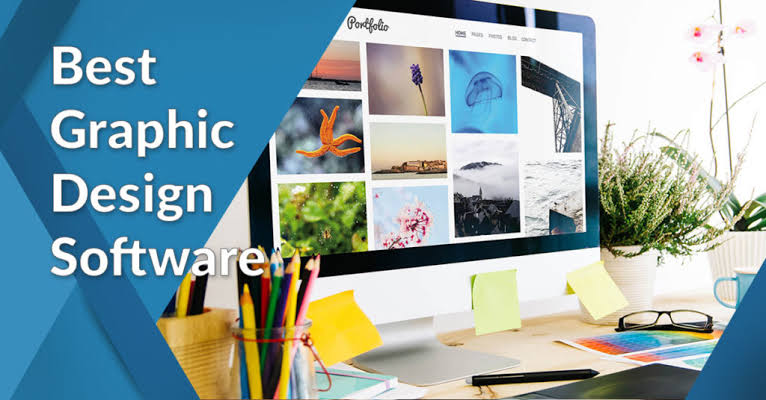Explore the top 10 graphic design software tools, from industry leaders like Adobe Photoshop and Illustrator to user-friendly options like Canva and GIMP. Learn about their features, benefits, and how they can enhance your design projects.
In todays communication landscape graphic design blends artistry with technology to create visuals that engage and inform. Be it for web platforms, print media or brand representation the use of software can significantly influence the results. This piece explores tools that are versatile and popular in the realm of design each designed to cater to different needs and skill levels.
Understanding Graphic Design Software
Graphic design software enables people to create and edit visual content. These programs offer features for tasks such, as photo editing graphic creation layout design and more. The choice of software varies based on project requirements, such, as design aesthetics preferred file types and personal preferences.
1. Adobe Photoshop
Adobe Photoshop is a graphic design software that is recognized globally. Its reputation stems from features that excel in photo editing, digital artwork and graphic design tasks. With an array of tools for altering images, constructing compositions and accommodating formats Photoshop provides flexibility. The editing framework combined with features like fill and customizable brush settings reinforces its status, among professionals in the field.
2. Adobe Illustrator
Adobe Illustrator is a powerful tool, for creating graphics. Unlike pixel based images vector graphics use formulas to create shapes that can be resized without losing quality. This software is ideal for designing logos, creating icons and doing illustration work. Its precision and versatility make it a strong asset for producing detailed and versatile artwork.
3. CorelDRAW
CorelDRAW is a popular software used for graphic design. Its user friendly interface and array of features make it a top pick for designers. With capabilities in vector drawing, layout design and photo editing CorelDRAW provides flexibility and versatility when handling file formats. Whether you're an experienced designer or a beginner this software has something to offer. Moreover it includes Corel PHOTO PAINT for image editing and Corel Font Manager for font organization.
4. Sketch
Sketch is a tool used in design specifically for making web and mobile layouts. UX/UI designers like it because its easy to use and focuses on organizing elements. It comes with features like symbols and artboards that streamline the design process and improve productivity. With its ability to support plugins and design frameworks Sketch offers a versatile approach, to creating captivating and customizable designs.
5. Affinity Designer
Affinity Designer serves as an alternative to Adobe Illustrator. Its combination of vector and raster design tools meets the requirements of graphic designers. Users value its interface and advanced capabilities, such, as performance and precise vector handling. These attributes make it a favored option for those seeking high quality results without overspending.
6. Inkscape
Inkscape is a graphic design tool that is open source. It offers features that can compete with paid software. Supporting formats and providing various tools for creating and editing vector graphics makes Inkscape a great option for those looking for a cost solution for vector design while preferring open source alternatives. The software benefits from a community and regular updates, improving its functionality and reliability.
7. Canva
Canva is a web based graphic design tool known for being easy to use and accessible. Its designed for people who want to create visuals such as social media graphics, slideshows and marketing materials. With its user friendly interface offering templates and a library of images, icons and fonts Canva allows for a simple drag and drop creation process. While it may not have the advanced features of software its simplicity and functionality make it a choice, for those without design experience.
8. Adobe InDesign
Adobe InDesign is the software of choice for desktop publishing and layout design. Its widespread use covers the production of both print and digital content such as brochures, magazines and eBooks. With its typography features, precise layout capabilities and smooth compatibility with other Adobe Creative Cloud applications InDesign is favored in the publishing field. Its expertise in handling documents and complex layouts further cements its position, in the industry.
9. GIMP
GIMP, short for GNU Image Manipulation Program is a free graphics editor that offers photo editing and design tools. Its functionality and customizable interface have drawn comparisons to Adobe Photoshop. Users can enhance GIMPs capabilities by adding plugins and extensions. With its cost and active community backing it caters to those seeking budget friendly alternatives.
10. Gravit Designer
Gravit Designer is a design tool that works in the offering free and paid versions. It has a user interface and offers features like editing shapes, managing text and customizing paths. This software is great for creating logos, icons and web graphics. Moreover its cloud based nature allows for collaboration and access on devices.
Choosing the Right Software
When selecting graphic design software it's essential to consider your needs, budget and proficiency. Software like Adobe Photoshop and Illustrator comes packed with features and is popular in the field. Conversely platforms such as Canva and GIMP provide options for novices or those seeking simpler solutions. Evaluate the pros and cons of each software to find the one that aligns with your design projects.
Conclusion
In the world of creativity graphic design software plays a role in turning ideas into reality. Whether its well known programs like Adobe Photoshop and Illustrator or user friendly options like Canva and GIMP the choice of software can significantly impact the quality and efficiency of your design work. Understanding the features and benefits of these popular graphic design tools allows you to choose the one that best suits your needs and supports your artistic goals.
